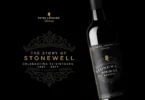 Sherry is a fortified wine, made in and around the town of Jerez, Spain. according to Spanish Law, sherry must come from the small triangular area of the province of Cádiz, between Jerez, Sanlúcar de Barrameda, and El puerto de Santa María.
Sherry is a fortified wine, made in and around the town of Jerez, Spain. according to Spanish Law, sherry must come from the small triangular area of the province of Cádiz, between Jerez, Sanlúcar de Barrameda, and El puerto de Santa María.
Sherry differs from other wines because of how it is treated after fermentation. After fermentation is complete, it is fortified with brandy. Because the fortification takes place after fermentation, all natural sherries are dry; any sweetness is applied later. In contrast, port wine is fortified halfway through fermentation, stopping fermentation, so not all the sugars are allowed to turn into alcohol and so leaving a sweet wine. Once bottled, sherry does not benefit from further ageing and may be consumed immediately, though the sherries that have been aged oxidatively may be stored for years without losing their flavour.
Fino (‘fine’ in Spanish) is the driest and palest of the traditional varieties of Sherry.
Manzanilla is a variety of fino Sherry made around the port of Sanlúcar de Barrameda.
Amontillado is a variety of Sherry that has been aged first under a cap of fl or yeast, and then is exposed to oxygen, which produces a result darker than fino but lighter than oloroso.
Oloroso (‘scented’ in Spanish) is a variety of Sherry aged oxidatively for a longer time than a fino or amontillado, producing a darker and richer wine. With alcohol levels between 18–20%, olorosos are the most alcoholic Sherries in the bottle.
Leave a Comment
You must be logged in to post a comment.





